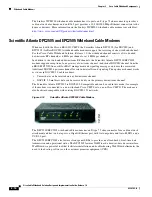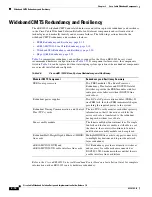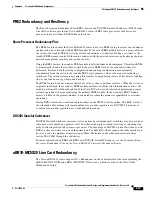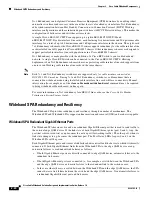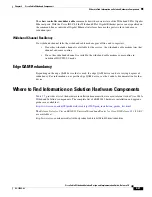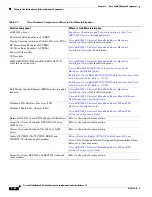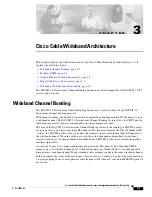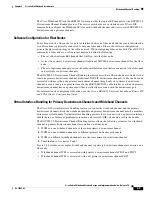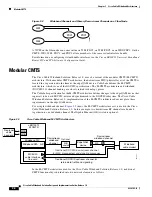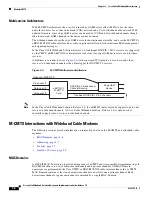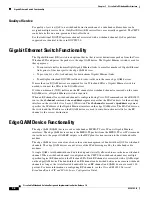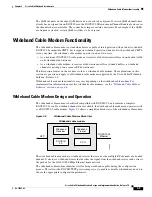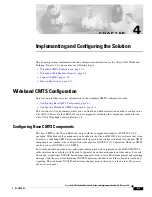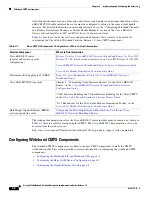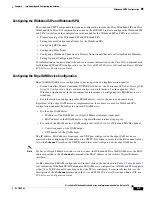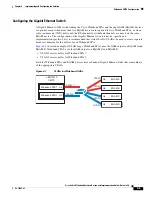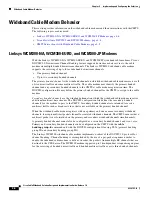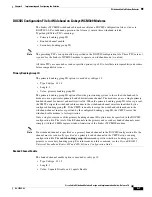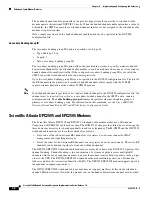
3-7
Cisco Cable Wideband Solution Design and Implementation Guide, Release 1.0
OL-10705-02
Chapter 3 Cisco Cable Wideband Architecture
Modular CMTS
A MAC domain is responsible for all MAC Management Messages to the set of cable modems that are
registered on that MAC Domain. A cable modem is registered to only a single MAC Domain.
A MAC Domain provides Layer 2 data forwarding services between the CMTS and the set of cable
modems registered to that MAC Domain.
In the downstream direction, the MAC Domain classifies downstream packets into downstream service
flows based on Layer 2, 3, and 4 information in the packets. The MAC Domain then schedules the
packets from each downstream service flow onto the set of downstream channels of the MAC domain.
The CMTS assigns a downstream service flow to either a single downstream RF channel or to a
Downstream Bonding Group for a wideband channel. A downstream sequence of bonded packets is
identified at the CMTS and wideband cable modem by a Bonding Group ID (BG ID). Packets destined
to different wideband cable modems can share the same Bonding Group ID. The CMTS assigns a
downstream service flow to either a single downstream RF channel or to a downstream Bonding Group
for a wideband channel.
For the Scientific Atlanta DPC2505 or EPC2505 wideband cable modem, each of the modem's unicast
service flows is sent as a bonded group and is tied to the modem's bonded downstream channel. A
downstream sequence of unicast bonded packets is identified at the CMTS and the cable modem by a
unique Downstream Service Identifier (DSID). Multicast traffic on bonded downstream channels is not
supported. Multicast service flows that the modem sees on the bonded downstream channel are
discarded.
In the upstream direction, the behavior and handling of traffic by the CMTS is identical to the
DOCSIS 2.0 behavior and handling.
Addressing
All addressing is done with Ethernet and IP addresses. The wideband cable modem uses the same IP
address space as a standard cable modem so it is able to use the same DHCP procedure to procure an IP
address.
The DOCSIS 3.0 Downstream Channel Bonding feature does not limit the number of wideband cable
modems that can exist on a downstream channel. The limit is set either by the availability of bandwidth,
or by the 8175 service identifiers (SIDs) limit in DOCSIS 2.0.
Because wideband channels and a traditional DOCSIS channel can be within the same subnet, a
wideband cable modem can be moved between services without the need to change the IP address space
of the home network.
Since the IP address space is homogeneous, it is not necessary to have a NAT function in the wideband
cable modem. The rules for distribution of IP address for a home network with a wideband cable modem
are the same as for a DOCSIS 2.0 cable modem.
Security
A wideband channel uses Baseline Privacy Plus (BPI+) for its link level encryption. As with
DOCSIS 2.0, BPI+ provides cable modem users with data privacy across the cable network by
encrypting traffic flows between the wideband cable modem and the wideband CMTS. BPI+ also
provides MSOs with protection against theft of service.
The wideband cable modem uses the same BPI+ keys on its wideband channels as it does on its
traditional DOCSIS channel. The wideband cable modem uses the BPI+ keys negotiated on the primary
service flow of the traditional DOCSIS downstream channel for the service flows on the wideband
channel.


